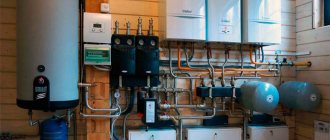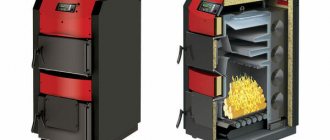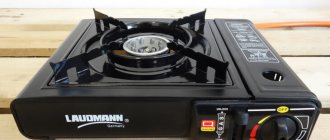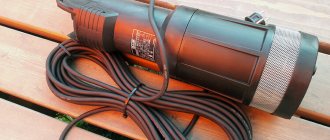There are different models of such devices, which differ in the principle of operation, accuracy and method of adjustment.
The technical parameters of stabilizers must meet the requirements for the supply voltage of electrical appliances connected to it.
The automation of gas boilers is especially sensitive to surges in the household electrical network and quickly fails when the quality of energy is low. Experts advise installing a voltage stabilizer at the installation stage of the heating system, so as not to encounter system shutdowns, freezing and breakdowns in the future.
We have collected for you the best models of protective devices presented on the Russian market in 2021 in terms of price/quality ratio.
When compiling the ratings, we focused on the technical capabilities of voltage stabilizers, price and durability.
Rating of the TOP 15 best voltage stabilizers for gas boilers in 2021
| Place | Name | Price |
| TOP 4 best voltage stabilizers for gas boilers in price/quality ratio for 2021 | ||
| 1 | Resanta ASN-10000N/1-C Lux | Find out the price |
| 2 | ENERGY APC 500 | Find out the price |
| 3 | Defender AVR Typhoon 1000 | Find out the price |
| 4 | Calm IS350 (0.3 kW) | Find out the price |
| TOP 4 best inverter voltage stabilizers for gas boilers | ||
| 1 | Shtil IS1500 (1.125 kW) | Find out the price |
| 2 | RESANTA ACH-600/1-I (0.6 kW) | Find out the price |
| 3 | BAXI Energy 400 (0.35 kW) | Find out the price |
| 4 | Calm IS550 (0.4 kW) | Find out the price |
| TOP 4 best 220 V voltage stabilizers for gas boilers | ||
| 1 | Energy ACH 5000 (2019) | Find out the price |
| 2 | RESANTA LUX ASN-5000N/1-C (5 kW) | Find out the price |
| 3 | ERA SNPT-2000-C | Find out the price |
| 4 | SVEN AVR SLIM 500 LCD (0.4 kW) | Find out the price |
| TOP 3 best voltage stabilizers for 500 W gas boilers | ||
| 1 | RESANTA LUX ASN-500N/1-C (0.5 kW) | Find out the price |
| 2 | ERA SNK-500-M (0.5 kW) | Find out the price |
| 3 | SVEN VR-L1500 (0.5 kW) | Find out the price |
Choosing the right model
For those who are too lazy or have no time to figure it out, I offer a list of 220V voltage stabilizers for gas boilers, which are guaranteed to fit any boiler. Sorted in order of increasing quality.
Resanta ACH-500/1-C
Type - relay Power - 500 W Input voltage - 160...240 V Response time - 7 ms Number of adjustment stages - 4 Output - 1 Euro socket
Built-in protection against short circuit, overheating, overvoltage and interference is declared. Connect to the network strictly with a grounding conductor (European standard plug).
Despite the Russian name and Latvian roots, this is real China in the bad sense of the word. Low-quality components are used, the build quality is simply disgusting. The most common problem is an unreliable contact in one of the trimming resistors (a temporary solution is to twist it back and forth, but generally replace it).
The next weak point: poor contact at the terminals of the autotransformer (the winding, by the way, is made of aluminum wire). Dried or swollen electrolytes come across, which also lead to unstable operation.
The wall-mounted version contains the letter “H” in the name and does not differ in anything except the shape of the case.
The declared power of 500 W is achieved only with an input voltage above 190V. Already at 180 volts, the power drops to 400W. The manufacturer does not hide this - the instructions show a graph of the dependence of power on input voltage .
The lower the voltage, the higher the currents and the hotter the transformer gets. At some point, the built-in thermal relay turns off the stabilizer. Although, as practice shows, protection does not always work. Here, enjoy:
The output voltmeter always shows 220V, as if drawn. In this case, the output may actually be, for example, 240V. There are, however, old models with pointer voltmeters - they show it as it is.
I do not advise anyone to buy the Resanta ACH-500/1-C stabilizer.
Bastion Teplocom ST-555
Type - relay Power - 280 W Input voltage - 145...260 V Response time - 20 ms Number of adjustment stages - 3 Output - 1 Euro socket
Another device from a Russian manufacturer. I still don’t understand why they ask for that kind of money.
The inside is not only very modest, but also not very neat. The board with the “brains” was simply shoved between the housing posts, and to prevent it from dangling, it was secured with hot-melt glue from a glue gun. And this is in a device that will obviously heat up during operation! Even the Chinese don’t allow themselves to do this...
A regular fuse was plugged into the gap in one of the wires on the board. To replace it, you will have to open the lid.
If cheap Chinese stabilizers at least have an automatic fuse, here they don’t even have that. I’m generally silent about a full-fledged automatic machine with an electromagnetic release.
Honestly, everything is some kind of toy and does not inspire confidence. It seems that the stabilizer was cobbled together from what was at hand. In general, the Bastion product undermined my faith in the Russian manufacturer.
And then this blue illumination from the inside... Some people may like it. But if you don’t like it, then you still can’t get away from it, because you can’t close the ventilation holes.
On the other hand, if you hang the stabilizer somewhere in the corridor, it will successfully act as a night light.
However, this mysterious internal glow is assigned the function of indicating the status of the stabilizer. The transcript is printed on the side wall:
But, Christmas tree sticks, how can I imagine such illumination in combination with loudly clicking relays! Yeah... In my opinion, all this is very much for everyone.
In the original version there is nothing at all on the front panel, except for a couple of inscriptions. But there is a version with a digital voltmeter - Teplocom ST-555-I. Which, by the way, also shines with blue light.
The manufacturer couldn’t come up with anything better than to move the socket outside on a wire (probably, he didn’t want to develop a separate housing for this model). Moreover, he did it in a very original way, without bothering too much - the wires were simply pushed through the first holes that came across:
Despite my negative attitude towards this model, the Bastion Teplocom ST-555 voltage stabilizer performs its functions as stated. The price, in my opinion, is greatly overpriced.
Sven AVR Slim-500
Type - relay Power - 400 W Input voltage - 140...260 V Operating temperature - 0...40°C Response time - 10 ms Number of adjustment stages - 4 Output - 1 Euro socket
Inside the durable metal case there is a toroidal autotransformer with an overheating sensor and 4 power relays that switch the windings.
The brains are assembled on one board based on the HT46R064B microcontroller. Despite its Chinese roots, the stabilizer has quite decent installation quality.
Although there is only one digital voltmeter, it is a real one. It honestly shows either the input voltage or the output voltage (what exactly to show at the moment is selected by a button).
Overall, a nice model. Lightweight, flat body (thickness only 6 cm). Cooling is natural. The mount is designed as a wall mount, but you can put it anywhere without any problems.
Now the fly in the ointment. The interference filter built into the Sven AVR Slim-500 voltage stabilizer is completely useless. They stuck this flimsy connector into the board solely for the sake of making a proud inscription on the packaging. Protection against short circuits at the output is implemented using a simple bimetallic circuit breaker (have you probably seen these? They are still shoved into cheap surge protectors). Well, a plus from long-term overload should be saved by the temperature sensor of the autotransformer.
The stabilizer has a twin brother - the SLIM-1000 LCD model. The housing is the same, but due to a more powerful transformer, the power is increased to 1000 VA.
Powerman AVS 1000D
Type - relay Power - 700 W Input voltage - 140...260 V Operating temperature - 0...40°C Response time - 7 ms Number of adjustment stages - 6 Output - 2 Euro sockets
If the input voltage drops below 120 or above 280 Volts, the stabilizer will de-energize the load. By the way, the values of the input and output voltages are displayed on two independent digital voltmeters located on the front panel.
It's put together very well. The installation is neat, nothing interferes with the natural circulation of air. The transformer is toroidal, which has already become the de facto standard for household stabilizers. This increases efficiency, reduces dimensions, weight and reduces noise levels.
The entire control circuit is assembled on an 8-bit HT46R064 controller and one logic chip. It’s not clear why the manufacturer put the controller in the crib? Maybe for the sake of the possibility of flashing? But then where can I get the firmware?
The Powerman AVS 1000D voltage stabilizer implements an interesting solution to the problem of power relay reliability. It is no secret that one of the most common failures of relay stabilizers is the failure of the relay contact group as a result of burning or sticking contacts. Here this problem is solved head-on - they installed relays with a 3-fold power reserve.
Despite the fact that the manufacturer claims protection from interference, no signs of filter elements were found in the inside of the stabilizer. There are no chokes, no capacitors, no varistors.
Therefore, to protect the gas boiler from pulse and high-frequency interference after the Powerman AVS series voltage stabilizers, it is advisable to always use a separate surge filter.
This model has a floor-standing design, which may not be very convenient when used in conjunction with a wall-mounted boiler.
In this case, I recommend paying attention to a slightly less powerful version of the Powerman AVS 500P stabilizer, which is designed for wall mounting (see photo on the right).
Its active power is 250 W, which is enough for most gas boilers. Even in excess. The quality of this model is not inferior to its older brother.
Rucelf Boiler-600
Type - relay Power - 600 W Input voltage - 150...250 V Operating temperature - 0...45°C Response time - 20 ms Number of adjustment stages - 4 Output - 1 European socket
Stabilizer allegedly made in Russia. This is indicated by a large inscription and a body painted in bright patriotic colors. In fact, the Rucelf company is registered in Russia, but all products are still assembled in China. But even despite the low-paid labor of Chinese workers, the build quality did not suffer.
The body is metal and looks solid. Designed for wall mounting, socket at the bottom. A full power of 600 watts will be enough for absolutely any boiler. And so that no one has any doubts, the inscription “Recommended for gas boilers” appears on the front panel.
The interior is also at a decent level. No interference with the glue gun was noticed, the soldering was clean and neat. There are no empty spaces on the board. Everything you need is insulated with heat shrink and secured with clamps and screws. The autotransformer is completely isolated.
By default, the digital voltmeter shows the output voltage, but if you press the red button below, it will switch to the input voltage. It works quietly (if compared with the same Teplokom, it is generally silent). Own consumption is about 2 W.
The appearance, as well as the interior decoration, can be assessed in this video:
Energy APC 500
Type - relay Power - 350 W Input voltage - 85...270 V Operating temperature - -5...40°C Response time - 10 ms Number of adjustment stages - 4 Output - 2 CEE 7/4 sockets
Our, domestic stabilizer. The metal body will not melt in the event of some force majeure, unlike the same Resanta. In addition, this is an additional plus for fire safety. The assembly is on par, it looks nice, it’s nice to hold it in your hands. Everything is neat inside too.
An extremely wide range of input voltages is declared. In short-term mode, the stabilizer is capable of operating from 75 Volts to 280. But we must keep in mind that the stub will only produce 100% power starting from 195V at the input.
By the way, about the output voltage. On the front panel of the Energy APC 500 voltage stabilizer there are two digital voltmeters showing the input and output voltage. So, the output voltage is ALWAYS exactly 220 Volts. In reality, this is, of course, a dummy. But I understand perfectly why the manufacturer made such a cunning move.
The fact is that not all users understand that the normal voltage of a household network of 220 Volts is any voltage in the range of 198-242 Volts. Imagine what will happen to an ignorant person when he sees, for example, 240V on the output voltmeter? He will decide that this is a disaster! The stabilizer is broken!!!
Therefore, the output is always clearly 220, and everyone is happy 
Pay attention to the CEE system socket (an invention of the German company Schuko). Here, the contact of the grounding conductor is made in the form of a pin, which fits into the corresponding recess in the plug.
This design does not allow accidental reversal of phase and zero, which is unacceptable for phase-dependent boilers.
Some users are driven into a stupor by such forks. Look, for example, how surprised the author of this video is:
The inscription on the stabilizer body that it is “ideal for a gas boiler” is an excellent example of the exploitation of our illiteracy and laziness. Just imagine, you need a stabilizer, but you don’t understand anything about them. And so you accidentally walk into a store, and on the counter there is a box on which it is written in large letters: “I am just for the boiler! Don’t think about anything, just buy me!” Marketing rules.
Regardless of what it says on it, Energy APC 500 is truly an excellent stabilizer for wall-mounted gas boilers!
Shtil InStab IS550
Type - double conversion (inverter) Power - 400 W Input voltage - 90...310 V Operating temperature - 5...40°C Response time - none (0 ms) Overload.
capacity - 50% (5s) Output - 1 Euro socket Shtil InStab IS550 is one of the best examples of inverter stabilizers, possessing all their advantages. The stabilizer has a fantastic range of operating voltages - from 90 to 310 volts, so it is ideal for even the most problematic networks (for example, in the winter at the dacha during peak load hours, when even the light bulbs dim). The manufacturer claims stabilization accuracy is 2%, but in practice the accuracy is even higher (less than 1%).
It’s nice that the stabilizer is our domestic development - the group includes enterprises from Moscow and Tula. The InStab 550 model has certificates of conformity from the State Standard of the Russian Federation, the Ministry of Information and Communications of the Russian Federation, declarations and certificates of the Customs Union and has passed production tests and final control.
The stabilizer is completely silent. Due to the low power, cooling occurs due to natural convection, and there is not a single fan inside:
But inside there is a full-fledged surge filter with a notch band of 150 kHz-30 MHz, which will protect your equipment from interference (and, conversely, will not allow interference into the network that may occur during the operation of some household appliances). So everything is in strict accordance with GOST for electromagnetic compatibility. And these are not empty words. If you remove the cover, you will immediately notice the components necessary for high-quality filtering of interference:
But what will happen if you apply a rectangular voltage (meander) to the InStab 550 input, which is produced by a regular Chinese uninterruptible power supply:
As you can see, the stabilizer turned the rectangular pulses arriving at its input (red oscillogram) into an ideal sine wave at the output (yellow oscillogram).
In general, inverter stabilizers are the last word in the world of stabilizers. The use of double voltage conversion technology has achieved unprecedented benefits:
- complete absence of delay time between changes in input voltage and corresponding correction of output voltage;
- complete absence of moving parts (servo-drive mechanism, switching relays) and, accordingly, absolute silent operation. The exception is powerful stabilizers with forced cooling, which, by the way, turns on only under a certain load;
- the absence of a bulky and heavy booster transformer and, as a result, less weight and dimensions of the entire device;
- wide range of input voltages;
- non-critical to the shape and frequency of the input voltage (it works without problems, for example, from cheap UPSs with a meander output or from diesel generators with their ever-floating frequency);
- improving the shape of the output voltage (always forms a smooth sine wave, regardless of what is supplied to the input).
As far as I know, it was Shtil Group of Companies that first decided to apply the idea of double voltage conversion in stabilizers. One of the first models was Shtil R500i , and the InStab IS550 we are considering is essentially its modern analogue, assembled on a more advanced and reliable element base.
Interestingly, you can officially purchase a version pre-configured for the desired output voltage: 220, 230 or 240V. So, those who wish can already gradually join the new voltage standard - 230 volts.
A good demonstration of the advantages of double conversion stabilizers is presented in this video (using the example of the Stihl IS550 stabilizer):
In general, no matter where you look, this stabilizer has the same advantages and advantages. But it still has one drawback - the price. For the 400-watt Shtil InStab IS550 you will have to pay 6,400 rubles. This is, of course, more expensive than any other type of stabilizer of the same power. However, there is no doubt that the development of technology and further reduction in the cost of powerful electronic components (IGBTs and MOSFETs) will inevitably lead to a reduction in the cost of inverter stabilizers.
By the way, for most gas boilers, the less powerful Stihl IS350 stabilizer may be sufficient (thus, you can save about 1.5 thousand rubles). Its ability to withstand 50% overload for 5 seconds will help withstand circulation pump starts.
Calm R600ST
Type - electronic (triac) Power - 480 W Input voltage - 165...265 V Operating temperature - 1...40°C Response time - 40 ms Number of adjustment stages - 4 Output - 2 Euro sockets
The only electronic voltage stabilizer for a gas boiler. There are no complaints about the build quality. Everything is thought out, reliable contacts, insulation, removal of warm air. Looks beautiful. Cooling is carried out due to natural air circulation, which means complete absence of noise during operation.
The circuitry is also at a high level. Triac switches with a power reserve are used, due to which the actual operating voltage expands a little more - from 150 to 275 Volts.
And, importantly, Shtil R600ST has its own interference filtering circuit (both from the network side and, conversely, from the stabilizer side). This is facilitated by a separate output circuit for each of the sockets.
Shtil is produced in Russia (Tula) and meets all the requirements of international standards. Stihl stabilizers are widely used by Internet providers, banks, hospitals, i.e. where increased reliability is required. In my opinion, the R600ST model is the best voltage stabilizer for a gas boiler.
Stihl and Energia stabilizers very rarely come to our workshop, which indirectly indicates their reliability.
For clarity, we have summarized all of the listed models in one table. The result is a kind of rating of voltage stabilizers for gas boilers:
| Stabilizer model | Type | Power | Operating voltage | Metal. frame | Built-in filter | Silent operation | Accommodation | Price | Overall rating |
| Resanta ACH-500/1-C | relay | 500 W | 160…240 V | floor | 1420 rub. | ||||
| Resanta ACH-500N/1-C | relay | 500 W | 160…240 V | wall | 1790 rub. | ||||
| Bastion Teplocom ST-555 | relay | 280 W | 145…260 V | wall | 3200 rub. | ||||
| Sven AVR Slim-500 | relay | 400 W | 140…260 V | wall | 1860 rub. | ||||
| Powerman AVS 1000D | relay | 700 W | 140…260 V | floor | 1810 rub. | ||||
| Rucelf Boiler-600 | relay | 600 W | 150…250 V | wall | 3000 rub. | ||||
| Energy APC 500 | relay | 350 W | 85…270 V | wall | 3600 rub. | ||||
| Calm IS550 | inverter | 400 W | 90…310 V | wall | 6400 rub. | ||||
| Calm R600ST | electronic | 480 W | 165…265 V | wall | 7200 rub. |
Of course, this is not an exhaustive list. When choosing a voltage stabilizer for wall-mounted gas boilers, be guided by the following characteristics:
- power;
- voltage range (depending on the characteristics of your network);
- quality of assembly and components;
- and placement method (for wall-mounted boilers, side-by-side wall placement is preferable).
How to choose a voltage stabilizer for gas boilers?
When choosing a device for protection against power surges, the main criteria should be the electrical power of the boiler itself and the parameters of the household electrical network to which it is connected.
- Voltage range . To know within what limits this parameter varies in your electrical network, invite a power quality control specialist. He will make all the necessary measurements and give recommendations for eliminating internal wiring problems, if any. Don't neglect this step! If you cannot influence the problems with overload of the transformer substation, then it is within your power to eliminate incorrect installation of electrical wiring or redistribute the load inside the house. This will protect expensive household appliances and save you money when buying a voltage stabilizer - the wider its range, the more expensive it is.
- Electric power of a gas boiler . This parameter is indicated in the technical data sheet of the equipment. Most gas boilers consume 100-200 W, but at peak load the power increases. When choosing a stabilizer, make a power reserve of 10-15% under normal power quality parameters and up to 2 times when the voltage drops in the mains up to 140 V.
- Supply line type . Choose a single-phase or three-phase device, depending on the electrical network to which it will be connected.
- Stabilization accuracy . The permissible maximum values are indicated in the technical documentation for the gas boiler, for example: 220 V ±5%.
- Mounting type . Voltage stabilizers for gas boilers are of floor and wall type. Consider how you will place the device when installing the heating system.
- Duration of operation and manufacturer's warranty . Inexpensive Chinese stabilizers last no more than 2-3 years. Manufacturers of Russian devices indicate in the documentation the service life of devices at 5-10 years.
Correct connection
So, now you know which stabilizer to choose for a gas boiler. It remains to find out the correct connection diagram.
If the boiler is dear to you (and their cost reaches 300 thousand rubles and more!), then it would not hurt to install a voltage control relay immediately after the input circuit breaker, and a surge protector directly in front of the boiler.
Typically, in places where heating boilers are used (rural areas, towns, cottages...), the power supply is provided by a two-wire overhead line with a TT grounding system. In such cases, an RCD with a setting current of up to 30 mA is also added.
It turns out something like this:
Attention! The gas boiler and stabilizer must be grounded (not shown in the diagram)!
To ground the boiler (and all other electrical appliances), the TT system must have a separate grounding loop, completely isolated from the neutral working conductor and the rest of the network. Grounding resistance is calculated in accordance with the requirements of the Electrical Installation Rules (clause 1.7.59).
What type of voltage stabilizer should I choose?
Depending on the type of adjustment, protective devices can be either smooth or discrete (stepped). The stabilization accuracy of devices of the second type depends on the number of steps and their size.
According to the principle of action, stabilizers are divided into groups:
- Electromechanical . Voltage regulation occurs by moving the autotransformer brush, which is moved by the servo drive. Mechanical type devices provide smooth and precise stabilization. They are resistant to voltage surges and quickly respond to changes in power supply parameters. However, due to wear and tear on moving parts, they require regular maintenance.
- Electronic . The devices operate on semiconductor elements - triacs, which serve as power switches. Electronic stabilizers are characterized by fast response, silent operation, the ability to withstand overloads for up to 12 hours and a long service life. The adjustment occurs on a discrete principle, with an accuracy of ±2.5%, for the most expensive models - up to 1%. Another advantage of triac models is their compactness. Please note that electronic stabilizers are more expensive than servo and relay ones.
- Relay . The simplest and most inexpensive devices. They are characterized by low output adjustment accuracy ±5-10%, so they are not suitable for all models of gas boilers. Their other disadvantages: noise, slow response, low reliability, inability to withstand overloads.
- Inverter . They are distinguished by a wide range of operating input voltage (115-300 V) and an efficiency of more than 90%. Also, these devices provide the smoothest and fastest adjustments, operate without noise and are easy to install due to their compact size. Disadvantages: high cost and sensitivity to increased load.











